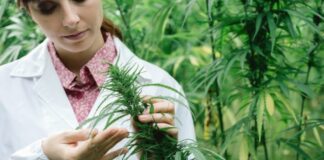In Southern Oregon the busy fall harvest is in full swing. The long, warm summers, rich native soil, and excellent sunlight make this one of the best natural landscapes to cultivate cannabis. Farms big and small alike dot the rugged countryside. The long, laborious growing season winds down as the days get shorter and the cannabis grown here reaches peak ripeness.
The hard work doesn’t stop once the plants are done flowering. In fact it picks up as the big, beautiful plants at Phantom Farms are ready to come down with the rest of this season’s harvest. To see how the team at Phantom tackles the immense task of harvesting their entire farm and to witness how life on the farm changes this time of year they invited me to visit their their picturesque slice of the Oregon countryside.
After a long, winding drive through the central Oregon countryside I arrive at an otherwise non-descript gated farm. Once inside I meet up with one of Phantom’s lead cultivators Kris Edin. Kris is a thoughtful and careful grower who spends every day keeping a close eye on the farm’s operations and each individual plant as they flourish throughout the growing season.
At the height of their growth spurt, plants can rise inches each day, and keeping up with the rapid changes is a full-time job when growing commercially.
A normal day for Kris starts by checking and assessing the general health of each plant, including scouting for any pests or other unsavory nuisances that might pray on the leaves. Apart from this care, Kris’s time is spent maintaining the irrigation system, training plants to support the weight of their heavy buds, and managing the fast growth that cannabis experiences as it progresses from vegetative growth to bloom.
These are just a few examples among countless other measures him and his team take to ensure plant health. At the height of their growth spurt, plants can rise inches each day, and keeping up with the rapid changes is a full-time job when growing commercially.
Hasty Growth and the Beginning of Harvest
Once the plants near the end of flowering, things on the farm start to change. Mornings are spent analyzing each plant’s ripeness and determining when they are ready to be harvested. To stay organized, Kris maps out which plants are set to harvest first as well as which yields are destined for smokable flower and which for concentrate production.The success of a harvest—and ultimately the entire growing season—are paramount, so a portion of the day is dedicated to troubleshooting and addressing any potential issues as early as possible. Kris explains that things can go downhill fast if you don’t keep a watchful eye on all aspects of harvest and monitor them carefully. The main idea is to build efficiencies that don’t sacrifice quality, which leads to Phantom taking a very hands-on approach to the whole process.
Smoky skies blocked out crucial UV rays that would have otherwise encouraged growth and overall size of the plants.
To understand when each strain is ripe and ready to cut down, Kris and his team look for the clear trichomes of the plant to turn milky and eventually amber. This, along with the overall density and bulk that the buds have taken on, help Phantom Farms manage the balancing act of harvesting each strain at just the right time.
Every cultivar is different; but once plants have been identified and mapped, the first step is to harvest the tops. These are the main colas of the plant and are usually the most developed and highest quality. These branches are harvested for their dried flower while the rest of the plant remains in place to finish ripening over a few more days depending on the strain and current weather conditions.
The lower parts of the plant are most often reserved for oil extraction. Harvesting each part of the plant in waves allows Phantom to find some common ground between harvesting at the pinnacle of ripeness and the sheer volume of plants they have to take down.
As is becoming the unfortunate norm, southern Oregon and other parts of the cannabis growing regions of the West Coast experienced devastating wildfires. The fires happened much earlier in the season than in years past, so while they didn’t have a detrimental effect on the later stages of flowering, they did stunt the overall growth of the plants. Smoky skies blocked out crucial UV rays that would have otherwise encouraged growth and overall size of the plants.
Late Summers Bring New Harvest Opportunities
 (Will Hyde/Leafly)
(Will Hyde/Leafly)
Now, in the waning days of October, we couldn’t ask for better weather. It was bright, sunny, and in the low 70s—dry and warm. Perfect for harvesting and drying cannabis with minimal fear of bud rot.
Once topped, the freshly harvested branches are binned and tagged to make sure everything is tracked through a state-mandated track and trace system. From there, the bins head to the shop where the crew is ‘big leafing.’ This process removes all the excess fan leaves to help expedite drying by removing some unwanted biomass and water weight.
They are careful not to remove all the leaves, as some cover from smaller fan and sugar leaf can actually help protect the resin throughout the drying and curing process.
Nearly every part of the plant stays within the farm’s ecosystem. Leaves and other waste get composted right on site. Phantom Farms use the discarded plant matter to feed their worms and compost teas which encourages healthy living soil. There is very little waste to anything that takes place on the farm, especially if it is part of the cannabis plant.
Harvest season is exciting, but it takes a lot of care, hard work, and attention to detail to ensure success.
After the branches have been big leafed, the bins are weighed and tracked again. Keeping crucial harvest data throughout the process helps Phantom optimize their operations and processes while maintaining compliance with state regulators. From there, bins head up to the drying room where they hang on dry lines in an environment controlled for the right temperature and humidity to evenly and delicately dry the flower.
The harvest team is constantly adjusting environmental controls and keeping a watchful eye on the drying rooms as any microbial infestation can spread fast. Kris points out that it’s a simple process, but the team has to stay on top of it to ensure they maintain quality and consistency in their flower.
 (Will Hyde/Leafly)
(Will Hyde/Leafly)
Once dried, the branches are put into large totes where each batch will be staged and stored for the next phase in harvest: bucking. Bucking removes the individual flowers from each branch, as well as big stems before prepping buds for the final trim. Bucked flowers are put into buckets which will soon be shipped to Phantom Farms’ curing and distribution facility in Bend, Oregon.
Every step of harvest is important. Nothing can be overlooked or overstated, and it continues even after the buds have dried and are curing. Work on the farm is a year-round. Once the entire plant has been taken down, next comes the task of preparing the land for the winter months and ensuring the beds and soil are rich and ready to nourish next season’s crop.
 (Will Hyde/Leafly)
(Will Hyde/Leafly)
To encourage healthy and bio-diverse soil, Kris uses a number of cover crops meant to encourage nutrient-rich soil that will grow and eventually turn to compost to feed Phantom’s next round of cannabis. Once complete, the next few months will be spent evaluating this year’s results while they plan, optimize, and grow towards the future.
Find your favorite strain nearby.
Harvest season is exciting, but it takes a lot of care, hard work, and attention to detail to ensure success. The love and pride Phantom Farms takes in their cannabis shines bright, and I for one can’t wait to taste the fruits of their labor.
















